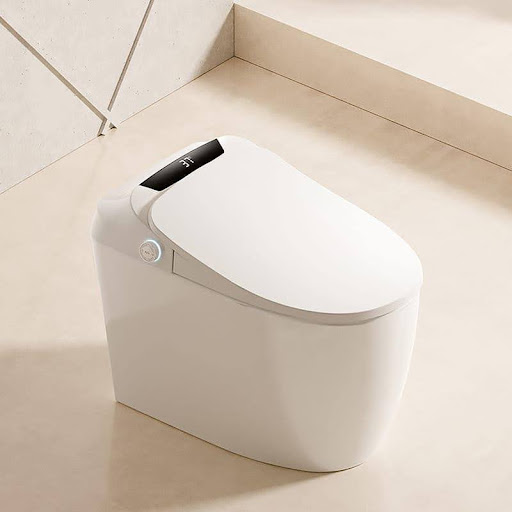One of the innovations gaining traction in recent years is touchless toilet technology. Designed to eliminate the need for physical contact, touchless toilets offer improved cleanliness, water efficiency, and ease of use.
Touchless toilets use sensors and automation to provide a more sanitary and convenient bathroom experience. But how exactly do they work? And what can you expect when using one?
In this article, we’ll explore the technology behind touchless toilets, including motion sensors, infrared sensors, and automatic flushing mechanisms, to give you a complete understanding of how these modern toilets function.
What is a Touchless Toilet?
A touchless toilet is a bathroom fixture equipped with sensors that detect motion or proximity to trigger various actions, such as flushing or activating other features like lighting or seat adjustments.
In a typical hands-free toilet, infrared or motion sensors are used to detect when the user has finished using the toilet. Once detected, these sensors automatically trigger the flushing mechanism, reducing the risk of cross-contamination between users.
Touchless toilets are commonly found in commercial settings, such as airports, shopping malls, and office buildings, but are increasingly being incorporated into residential bathrooms as well.
For example, the Japanese automatic touchless flush toilet is a great example of how modern touchless toilets incorporate advanced sensors and technology to enhance both hygiene and comfort in the bathroom.
Key Components of Touchless Toilet Technology
To understand how touchless flush toilets work, it’s important to break down the key components of the system: motion sensors, infrared sensors, and automatic flushing mechanisms.
1. Motion Sensors
Motion sensors are a fundamental feature of many touchless toilets. These sensors are designed to detect movement within a certain range, usually within a few inches to a few feet of the toilet. When a person enters or exits the toilet area, the sensor detects the motion and triggers a response, such as activating the flushing mechanism.
There are different types of motion sensors used in touchless toilets:
- Passive Infrared Sensors (PIR): These sensors detect changes in infrared light (heat) emitted by a person’s body. They are typically used to detect the presence of the user when they approach or move away from the toilet. PIR sensors can also be used to activate other bathroom features, such as lights or exhaust fans.
- Ultrasonic Sensors: These sensors use sound waves to detect motion. Ultrasonic sensors can be more sensitive than PIR sensors and are often used in more advanced commercial touchless toilets for greater accuracy in detecting user movements.
2. Infrared Sensors
Infrared (IR) sensors are one of the most common types of sensors used in touchless toilets for automatic flushing. These sensors work by emitting infrared light that bounces off an object (such as a user’s body) and returns to the sensor. The time it takes for the infrared light to return determines whether the toilet has been used and, if so, when to activate the flush.
Infrared sensors are typically placed on the front of the toilet, near the flush valve. They are highly effective because they can detect movement from a distance without requiring the user to be within direct line of sight.
This makes infrared sensors perfect for use in hands-free toilets, as they can automatically flush the toilet when the user is detected without any need for manual interaction.
3. Automatic Flushing Mechanisms
The automatic flushing mechanism is the most important component of a touchless flush toilet. Once the sensor detects the user’s presence and the toilet is no longer in use, it sends a signal to activate the flush. There are two main types of automatic flushing mechanisms:
- Sensor-activated Flushing: This type of system uses the infrared or motion sensor to detect when the user has finished using the toilet. Once the sensor detects no further movement, it triggers the flush.
- Timed Flushing: Some touchless toilets are designed to flush after a set period of time, regardless of whether the user has left the seat or not. This can help save water if a user forgets to activate the flush themselves.
The best touchless toilet models are equipped with advanced sensors that ensure the flushing mechanism operates reliably every time, offering a hassle-free, hygienic experience. Many also feature water-saving features, such as dual flush systems, to ensure that only the necessary amount of water is used for each flush.
Benefits of Touchless Toilets
Now that we understand how touchless toilets work, let’s explore the key benefits they offer over traditional toilets.
1. Improved Hygiene
The most obvious benefit of a hands-free toilet is improved hygiene. In public spaces or even at home, toilet handles are a common source of bacteria, as multiple people touch them throughout the day.
By eliminating the need to touch the toilet handle, touchless toilets help reduce the risk of cross-contamination and keep your hands cleaner.
Additionally, touchless flush toilets can prevent the spread of germs in busy public restrooms, where users often move quickly and may not be as careful with their hygiene. This feature is especially important in high-traffic areas like airports, malls, and office buildings.
2. Convenience and Efficiency
Touchless toilets offer a level of convenience and efficiency that traditional toilets simply cannot match. The automatic flushing mechanism eliminates the need to manually press a lever or button after use, making them especially useful for busy, high-traffic areas where efficiency is key.
In addition, the commercial touchless toilet design is often built to be durable and capable of withstanding high usage, making them perfect for public restrooms.
For residential users, the convenience of a touchless flush toilet means less effort is required to operate the toilet, which is especially helpful for individuals with mobility issues or physical disabilities. The added convenience extends to maintaining cleanliness as well—since the toilet is designed to flush automatically, users don’t have to worry about leaving a toilet handle dirty.
3. Water Conservation
Modern touchless toilets are designed with water-saving features, which help conserve water and reduce utility costs. Many models are equipped with dual-flush systems, which allow the user to choose between a low-volume flush for liquid waste and a higher-volume flush for solid waste. This not only saves water but also ensures that each flush is optimized for efficiency.
Touchless toilets are often engineered to flush only when necessary, preventing unnecessary water waste. The sensors in hands-free toilets are designed to activate the flush only after use, ensuring that water is not wasted if the toilet is not used.
4. Reduced Maintenance
Because touchless toilets don’t require physical contact to operate, they can reduce the wear and tear on toilet handles, which are often subject to constant use. This can help reduce the frequency of repairs and the need to replace broken or malfunctioning handles.
Additionally, many models feature self-cleaning mechanisms that help keep the toilet bowl cleaner for longer periods of time, reducing the amount of time and effort needed for cleaning.
What to Expect from Touchless Toilet Technology
When purchasing a commercial touchless toilet or installing a best touchless toilet for your home, there are a few things to consider:
- Installation: While installing a touchless flush toilet is relatively simple for most professional plumbers, some models may require electrical wiring for the sensors and flushing mechanisms. It’s essential to ensure that the plumbing and electrical systems in your bathroom can support the new technology.
- Power Source: Most touchless toilets run on batteries or hardwiring. Battery-operated models are easy to install, but they may require periodic battery replacement. Hardwired models may cost more to install but provide longer-lasting performance.
- Cost: Touchless toilets generally cost more than traditional toilets due to the advanced sensor and flushing mechanisms. However, the long-term savings in water conservation and the benefits of increased hygiene may justify the initial investment.
- Maintenance: While touchless toilets generally require less maintenance than traditional models, it’s still important to clean and maintain the sensors and flushing components to ensure they operate correctly. Regular cleaning of the sensor area can prevent buildup from dust or other debris that could interfere with sensor function.
Conclusion
Touchless toilet technology is revolutionizing the way we think about bathroom hygiene and convenience. By incorporating motion sensors, infrared sensors, and automatic flushing mechanisms, touchless toilets offer a more sanitary, efficient, and user-friendly experience.
Whether in commercial settings or residential bathrooms, these hands-free toilets are becoming increasingly popular due to their hygiene benefits, water-saving features, and low-maintenance design.
For those seeking the best touchless toilet, exploring offerings from top toilet manufacturers can ensure you get a reliable and high-performing product suited to your needs.





























